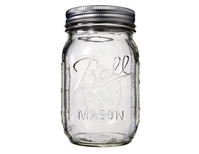








A Mason jar is a molded glass jar used in home canning to preserve food. The mouth of the jar has screw threads on its outer perimeter to accept a metal ring (or "band"). The band, when screwed down, presses a separate stamped steel disc-shaped lid against the rim of the jar. An integral rubber ring on the underside of the lid creates a hermetic seal to the jar. The bands and lids usually come with new jars, and bands and lids are also sold separately; while the bands are reusable, the lids are intended for single use when canning.
Invention History
The Mason jar was invented and patented in 1858 by Philadelphia tinsmith John Landis Mason (1832–1902). Among other common names for them are Ball jars,after Ball Corporation, an early and prolific manufacturer of the jars; fruit jars for a common content; and simply glass canning jars reflecting their material.
The earliest glass jars were called wax sealers, because they used sealing wax, which was poured into a channel around the lip that held on a tin lid. This process was complicated and error-prone, but it was largely the only one available for a long time, and widely used even into the early 1900s.
By far, though, the most popular form of seal was the screw-on zinc cap, the precursor to today's screw-on lids. The earliest successful application of this was discovered by Mason and patented on November 30, 1858, a date embossed on thousands of jars. Jars with "Patent Nov 30th 1858" were made in many shapes, sizes, and colors well into the 1900s. Since they were made in such quantity and used for such long periods, many of them have survived to the present day.